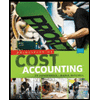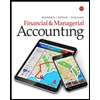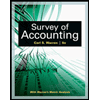
GARRISON MANAGERIAL ACCOUNTING CONNECT
17th Edition
ISBN: 9781264962938
Author: Garrison
expand_more
expand_more
format_list_bulleted
Concept explainers
Textbook Question
Chapter 2, Problem 16P
PROBLEM 2—16 Plantwide Predetermined
Landen Corporation uses a job-order costing system. At the beginning of the year, the company made the following estimates:
| Direct labor-hours required to support estimated production | 140,000 |
| Machine-hours required to support estimated production | 70,000 |
| Fixed manufacturing overhead cost | $784,000 |
| Variable manufacturing overhead cost per direct labor-hour | $2.00 |
| Variable manufacturing overhead cost per machine-hour | $4.00 |
During the year, Job 550 was started and completed. The following information is available with respect to this job:
| Direct materials | $175 |
| Direct labor cost | $225 |
| Direct labor-hours | 15 |
| Machine-hours | 5 |
Required:
- Assume that Landen has historically used a plantwide predetermined overhead rate with direct labor-hours as the allocation base. Under this approach:
- Compute the planide predetermined overhead rate.
- Compute the total
manufacturing cost of Job 550. - If Landen uses a markup percentage of 200% of its total manufacturing cost, what selling price would it establish for Job 550?
- Assume that Landen’s controller believes that machine-hours is a better allocation base than direct labor-hours. Under this approach:
- Compute the planPide predetermined overhead rate.
- Compute the total manufacturing cost of Job 550.
- If Landen uses a markup percentage of 200% of its total manufacturing cost, what selling price would it establish for Job 550?
- Assume that Landen’s controller is right about machine-hours being a more accurate overhead cost allocation base than direct labor-hours. If the company continues to use direct labor-hours as its only overhead cost allocation base what implications does this have for pricing jobs such as Job 550?
Expert Solution & Answer
Want to see the full answer?
Check out a sample textbook solution
Students have asked these similar questions
Consolidation Working Paper One Year after Acquisition, Bargain Purchase
On January 1, 2022, Paxon Corporation acquired 90 percent of the outstanding common stock of Saxon Company for $1.8 billion cash. The fair value of the 10 percent noncontrolling interest in Saxon was estimated to be $150 million at the date of acquisition. Paxon uses the complete equity method to report its investment. The trial balances of Paxon and Saxon
(in millions)
Cash and receivables
Inventory
Equity method investments
Investment in Saxon
Dr(Cr)
Paxon Saxon
$3,225 $855
2,260
530
December 31, 2022, appear below:
2,441.5
Land
650
300
Buildings and equipment, net
3,600 1,150
Current liabilities
(2,020)
(1,200)
Long-term debt
(5,000) (450)
(500)
(50)
Common stock, par value
Additional paid-in capital
Retained earnings, January 1
Dividends
Sales revenue
(1,200) (200)
(2,410) (600)
500
250
(30,000) (12,000)
Equity in net income of Saxon
(616.5)
Gain on acquisition
(250)
Gain on sale of securities
(150)
Cost of…
KIARA LIMITED
STATEMENT OF FINANCIAL POSITION AS AT 31 DECEMBER:
ASSETS
Property, plant and equipment (cost)
Accumulated depreciation
Long-term investments
Inventory
Accounts receivable
Company tax paid in advance
Bank
EQUITY AND LIABILITIES
2024
2023
R
R
2 490 000
1 620 000
(630 000)
660 000
1 050 000
1 230 000
30 000
(480 000)
450 000
1 290 000
900 000
0
750 000
660 000
5 580 000
4 440 000
Ordinary share capital
2 700 000
2 000 000
Retained income
1 500 000
1 158 000
Long-term loan from Kip Bank (15%)
900 000
1 000 000
Accounts payable
480 000
228 000
Company tax payable
0
54 000
5 580 000
4 440 000
ADDITIONAL INFORMATION
All purchases and sales are on credit.
Interim dividends paid during the year amounted to R150 750.
Credit terms of 3/10 net 60 days are granted by creditors.
Accounting Question
Chapter 2 Solutions
GARRISON MANAGERIAL ACCOUNTING CONNECT
Ch. 2.A - EXERCISE 2A-1 Activity-Based Absorption Costing...Ch. 2.A - EXERCISE 2A-2 Activity-Based Absorption Costing as...Ch. 2.A - EXERCISE 2A-3 Activity-Based Absorption Costing as...Ch. 2.A - PROBLEM 2A-4 Activity-Based Absorption Costing as...Ch. 2.A - Prob. 5PCh. 2.A -
CASE 2A-6 Activity-Based Absorption Costing and...Ch. 2.B - EXERCISE 2B-1 Overhead Rate Based on Capacity...Ch. 2.B - EXERCISE 2B-2 Overhead Rates and Capacity Issues...Ch. 2.B - Prob. 3PCh. 2.B - Prob. 4C
Ch. 2 - Prob. 1QCh. 2 - What is absorption costing?Ch. 2 - What is normal costing?Ch. 2 - How is the unit product cost of a job calculated?
Ch. 2 - Explain the four-step process used to compute a...Ch. 2 - What is the purpose of the job cost sheet in a...Ch. 2 - Explain why some production costs must be assigned...Ch. 2 - Why do companies use predetermined overhead rates...Ch. 2 - What factors should be considered in selecting an...Ch. 2 - If a company fully allocates all of its overhead...Ch. 2 - Would you expect the amount of applied overhead...Ch. 2 - Prob. 12QCh. 2 - What is a plantwide overhead rate? Whyare multiple...Ch. 2 - This Excel worksheet relates to the Dickson...Ch. 2 - This Excel worksheet relates to the Dickson...Ch. 2 - Prob. 3AECh. 2 - This Excel worksheet relates to the Dickson...Ch. 2 - Prob. 1F15Ch. 2 - Prob. 2F15Ch. 2 - Prob. 3F15Ch. 2 - Prob. 4F15Ch. 2 - Prob. 5F15Ch. 2 - Prob. 6F15Ch. 2 - Prob. 7F15Ch. 2 - Prob. 8F15Ch. 2 - Prob. 9F15Ch. 2 - Prob. 10F15Ch. 2 - Prob. 11F15Ch. 2 - Sweeten Company had no jobs in progress at the...Ch. 2 - Prob. 13F15Ch. 2 - Prob. 14F15Ch. 2 - Prob. 15F15Ch. 2 - EXERCISE 2-1 Compute a Predetermined Overhead Rate...Ch. 2 - Prob. 2ECh. 2 - EXERCISE 2–3 Computing Total Job Costs and Unit...Ch. 2 - EXERCISE 24 Computing Total Job Costs and Unit...Ch. 2 - EXERCISE 2-5 Computing Total Job Costs and Unit...Ch. 2 - Prob. 6ECh. 2 - EXERCISE 2-7 Job-Order Costing; Working Backwards...Ch. 2 - EXERCISE 2-8 Applying Overhead Cost; Computing...Ch. 2 - EXERCISE 2–9 Job-Order Costing and Decision Making...Ch. 2 - Prob. 10ECh. 2 - Prob. 11ECh. 2 - Prob. 12ECh. 2 - EXERCISE 2—13 Departmental Predetermined Overhead...Ch. 2 - EXERCISE 214 Job-Orders Costing for a Service...Ch. 2 - Prob. 15ECh. 2 - PROBLEM 2—16 Plantwide Predetermined Overhead...Ch. 2 - PROBLEM 217 Plantwide and Departmental...Ch. 2 - Prob. 18PCh. 2 - Prob. 19PCh. 2 - Prob. 20PCh. 2 - PROBLEM 2-21 Plant wide Versus Multiple...Ch. 2 - CASE 2-22 Plantwide versus Departmental Overhead...
Knowledge Booster
Learn more about
Need a deep-dive on the concept behind this application? Look no further. Learn more about this topic, accounting and related others by exploring similar questions and additional content below.Similar questions
- REQUIRED Study the information given below and answer the following questions. Where discount factors are required use only the four decimals present value tables that appear after the formula sheet or in the module guide. Ignore taxes. 5.1 Calculate the Accounting Rate of Return on average investment of the second alternative (expressed to two decimal places). 5.2 Determine which of the two investment opportunities the company should choose by calculating the Net Present Value of each alternative. Your answer must include the calculation of the present values and NPV. 5.3 Calculate the Internal Rate of Return of the first alterative (expressed to two decimal places). Your answer must include two net present value calculations (using consecutive rates/percentages) and interpolation. INFORMATION The management of Bentall Incorporated is considering two investment opportunities: (5 marks) (9 marks) (6 marks) The first alternative involves the purchase of a new machine for R900 000 which…arrow_forwardREQUIRED Use the information provided below to answer the following questions: 4.1 Calculate the weighted average cost of capital (expressed to two decimal places). Your answer must include the calculations of the cost of equity, preference shares and the loan. 4.2 Calculate the cost of equity using the Capital Asset Pricing Model (expressed to two decimal places). (16 marks) (4 marks) INFORMATION Cadmore Limited intends raising finance for a proposed new project. The financial manager has provided the following information to determine the present cost of capital to the company: The capital structure consists of the following: ■3 million ordinary shares issued at R1.50 each but currently trading at R2 each. 1 200 000 12%, R2 preference shares with a market value of R2.50 per share. R1 000 000 18% Bank loan, due in March 2027. Additional information The company's beta coefficient is 1.3. The risk-free rate is 8%. The return on the market is 18%. The Gordon Growth Model is used to…arrow_forwardA dog training business began on December 1. The following transactions occurred during its first month. Use the drop-downs to select the accounts properly included on the income statement for the post-closing balancesarrow_forward
arrow_back_ios
SEE MORE QUESTIONS
arrow_forward_ios
Recommended textbooks for you
 Principles of Cost AccountingAccountingISBN:9781305087408Author:Edward J. Vanderbeck, Maria R. MitchellPublisher:Cengage Learning
Principles of Cost AccountingAccountingISBN:9781305087408Author:Edward J. Vanderbeck, Maria R. MitchellPublisher:Cengage Learning College Accounting, Chapters 1-27AccountingISBN:9781337794756Author:HEINTZ, James A.Publisher:Cengage Learning,
College Accounting, Chapters 1-27AccountingISBN:9781337794756Author:HEINTZ, James A.Publisher:Cengage Learning, Managerial Accounting: The Cornerstone of Busines...AccountingISBN:9781337115773Author:Maryanne M. Mowen, Don R. Hansen, Dan L. HeitgerPublisher:Cengage Learning
Managerial Accounting: The Cornerstone of Busines...AccountingISBN:9781337115773Author:Maryanne M. Mowen, Don R. Hansen, Dan L. HeitgerPublisher:Cengage Learning Managerial AccountingAccountingISBN:9781337912020Author:Carl Warren, Ph.d. Cma William B. TaylerPublisher:South-Western College Pub
Managerial AccountingAccountingISBN:9781337912020Author:Carl Warren, Ph.d. Cma William B. TaylerPublisher:South-Western College Pub Financial & Managerial AccountingAccountingISBN:9781337119207Author:Carl Warren, James M. Reeve, Jonathan DuchacPublisher:Cengage Learning
Financial & Managerial AccountingAccountingISBN:9781337119207Author:Carl Warren, James M. Reeve, Jonathan DuchacPublisher:Cengage Learning Survey of Accounting (Accounting I)AccountingISBN:9781305961883Author:Carl WarrenPublisher:Cengage Learning
Survey of Accounting (Accounting I)AccountingISBN:9781305961883Author:Carl WarrenPublisher:Cengage Learning

Principles of Cost Accounting
Accounting
ISBN:9781305087408
Author:Edward J. Vanderbeck, Maria R. Mitchell
Publisher:Cengage Learning

College Accounting, Chapters 1-27
Accounting
ISBN:9781337794756
Author:HEINTZ, James A.
Publisher:Cengage Learning,

Managerial Accounting: The Cornerstone of Busines...
Accounting
ISBN:9781337115773
Author:Maryanne M. Mowen, Don R. Hansen, Dan L. Heitger
Publisher:Cengage Learning

Managerial Accounting
Accounting
ISBN:9781337912020
Author:Carl Warren, Ph.d. Cma William B. Tayler
Publisher:South-Western College Pub

Financial & Managerial Accounting
Accounting
ISBN:9781337119207
Author:Carl Warren, James M. Reeve, Jonathan Duchac
Publisher:Cengage Learning

Survey of Accounting (Accounting I)
Accounting
ISBN:9781305961883
Author:Carl Warren
Publisher:Cengage Learning
Cost Classifications - Managerial Accounting- Fixed Costs Variable Costs Direct & Indirect Costs; Author: Accounting Instruction, Help, & How To;https://www.youtube.com/watch?v=QQd1_gEF1yM;License: Standard Youtube License